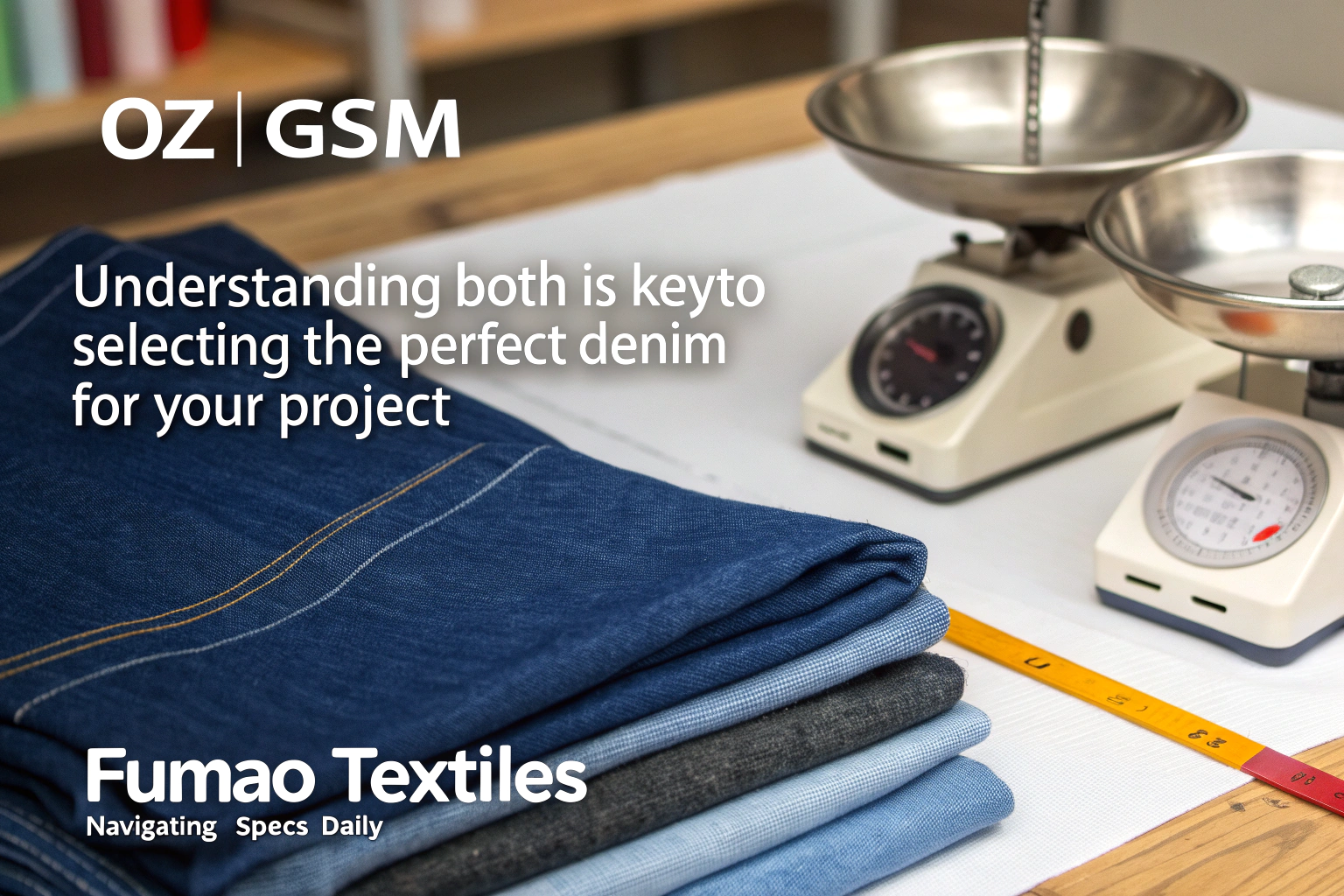Have you ever felt confused when a fabric supplier mentions denim weight in ounces, only to switch to GSM in the next sentence? You're not alone. Many of our clients, especially those new to sourcing denim from China, find this dual-measurement system puzzling. It can lead to mistakes in ordering the wrong fabric thickness, impacting the final product's look, feel, and performance. Getting this right is crucial for your denim line's success.
The core difference is that denim weight in ounces (oz) measures fabric weight per square yard, a standard in the US and for denim specifically, while GSM (Grams per Square Meter) measures weight per square meter, a global metric standard. They are two different units for measuring the same thing: the mass per unit area of the fabric. Understanding both is key to selecting the perfect denim for your project, whether it's a lightweight summer shirt or durable workwear. At Fumao Textiles, we help our clients navigate these specs every day to ensure they get exactly what their designs require.
Let's break down these two measurement systems so you can confidently specify and order denim for your fashion line.
What is Denim Weight in Ounces (oz/yd²)?
If you've bought denim from American or heritage brands, you've definitely encountered ounces. This is the traditional imperial unit for denim. When we say a fabric is "12 oz denim," we mean that one square yard of that fabric weighs 12 ounces. This measurement is deeply rooted in the history of denim, particularly in the workwear sector. It's a unit that tells a story of durability and tradition.
For denim, weight in ounces directly correlates with the fabric's thickness, durability, and typical use. It's the go-to language for many denim purists and brands that market authenticity. Our clients often use this measurement when they are targeting a specific market segment that values classic, heavyweight selvedge denim. The feel and drape of a garment are intrinsically linked to this number.
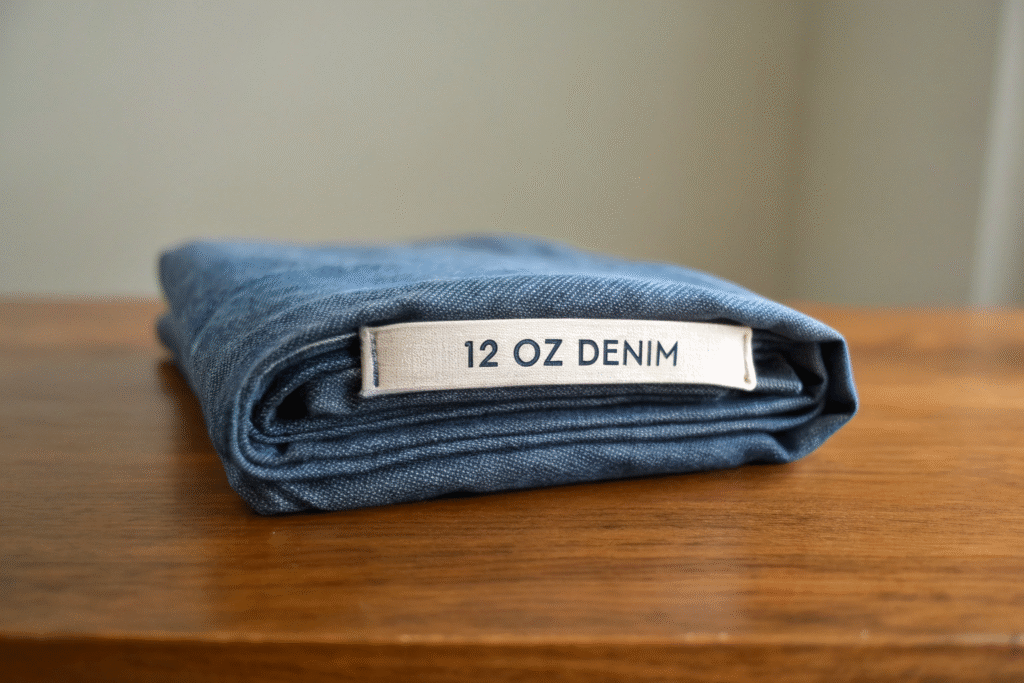
Why is the Ounce Measurement So Common for Denim?
The prevalence of the ounce is a historical artifact. Denim's origins are in durable workwear, and the imperial system was the standard in the United States, where denim became iconic. Mills like Cone Denim established these standards, and the tradition stuck. Even today, when you talk about a classic, rigid denim jacket, its weight is almost always described in ounces. It has become a badge of quality and heritage. For brands building a story around authenticity, specifying weight in ounces is a powerful tool.
How Does Fabric Weight in Ounces Affect Your Design?
The weight in ounces is a critical design decision. It dictates the garment's character. Lightweight denims (under 10 oz) are soft, pliable, and ideal for summer shirts, dresses, and comfortable, broken-in jeans. Mid-weight denims (10 oz to 14 oz) are the most versatile, offering a balance of comfort and structure, perfect for everyday jeans. Heavyweight denims (14 oz and above) are stiff, incredibly durable, and develop high-contrast fades over time, making them the choice for premium selvedge and workwear. Choosing the right weight ensures your design performs as intended for your target customer.
What Does GSM Mean for Fabric?
While ounces are the old guard, GSM is the global standard. GSM stands for Grams per Square Meter. It is a metric measurement used worldwide to specify the weight of all types of fabrics, not just denim. In our factory in Keqiao, we use GSM for most of our technical specifications and quality control checks because it aligns with international ISO testing standards. It provides a universal language for our clients in Europe, Asia, and beyond.
Think of GSM as the fabric's density. A higher GSM number means a heavier, denser, and often thicker fabric. This measurement gives you a quick, standardized way to compare different fabrics on a level playing field. When you are sourcing various materials beyond denim, GSM is the most efficient way to ensure consistency and meet your product's technical requirements.
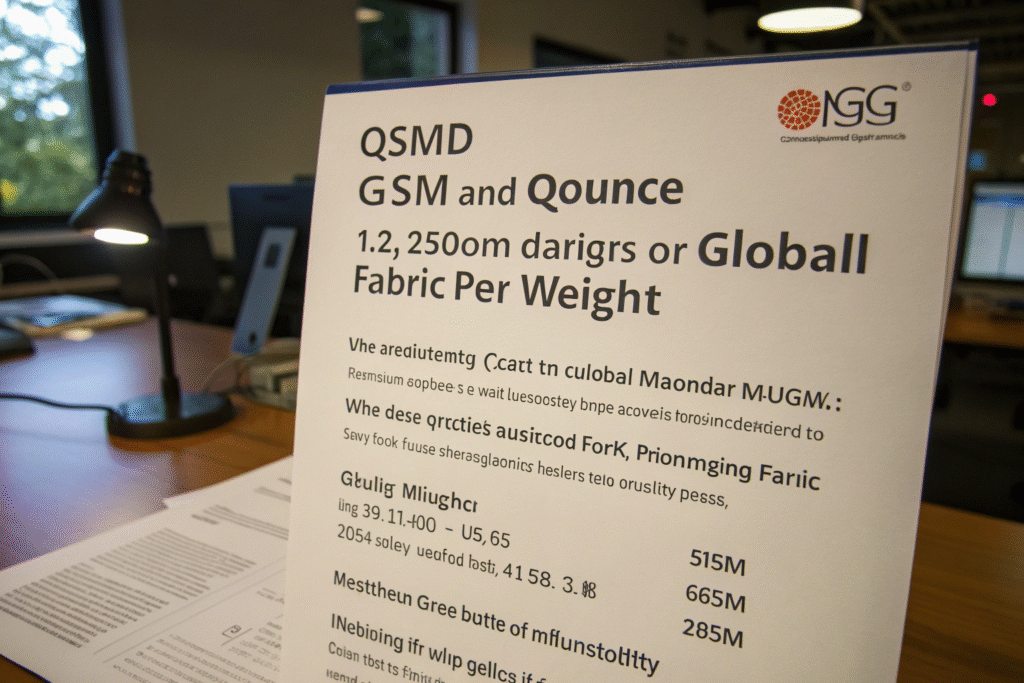
When Should You Use GSM as Your Primary Metric?
You should use GSM as your primary metric when you are producing for a global market, developing technical garments, or working with a variety of fabric types. If you are making performance activewear or a blend that includes Tencel™ or recycled polyester, GSM is the standard. It eliminates the confusion of unit conversion. Furthermore, many international retailers and large brands, like H&M or ZARA, require all fabric specifications in GSM for their tech packs to maintain global consistency across their supply chain.
Is GSM More Accurate Than Ounces?
No, GSM is not inherently more accurate than ounces. Both are precise units of measurement. However, GSM is often considered more consistent and universal because it is part of the metric system. The metric system is decimal-based, which simplifies calculations and reduces conversion errors. For a Chinese supplier like us, providing data in GSM ensures there is no miscommunication with partners from different countries, making the entire supply chain more efficient and reliable.
How to Convert Between Ounces and GSM?
You don't need to be a math whiz to switch between these units. The conversion is straightforward. Since one ounce equals 28.35 grams and one square yard equals 0.836 square meters, you can use a simple formula. This conversion is vital for comparing quotes and understanding fabric specs from different global sources.
The standard conversion factor is 1 oz/yd² = 33.906 GSM. To convert from ounces to GSM, you multiply the ounce value by 33.906. To convert from GSM to ounces, you divide the GSM value by 33.906. While the exact number is 33.906, many in the industry use a factor of 34 for quick mental math, which is accurate enough for most practical purposes.
| Denim Category | Weight (oz/yd²) | Approximate GSM |
|---|---|---|
| Lightweight | 7 - 9 oz | 235 - 305 GSM |
| Mid-weight | 10 - 14 oz | 340 - 475 GSM |
| Heavyweight | 15+ oz | 510+ GSM |
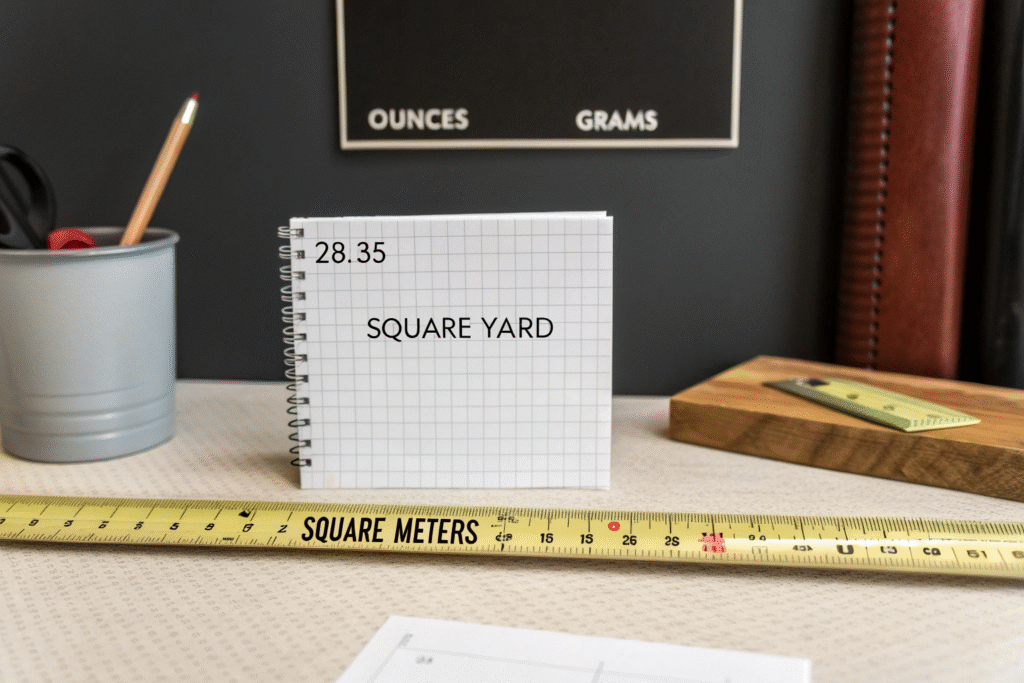
What is the Simple Formula for Conversion?
The simple formula is GSM = oz/yd² × 33.906. For example, to find the GSM of our popular 12.5 oz denim, you calculate 12.5 × 33.906. The result is approximately 424 GSM. Conversely, if a European mill offers you a 350 GSM denim, you can calculate the ounce weight by dividing 350 by 33.906, giving you about 10.3 oz. We include these conversions in all our fabric spec sheets for client clarity.
Where Can Common Conversion Mistakes Happen?
The most common mistake is using the wrong conversion factor. People sometimes try to convert ounces directly to grams without accounting for the difference between square yards and square meters. This leads to a significant error. Another pitfall is assuming that a fabric labeled "10 oz" is exactly 10 ounces without verifying the tolerance from the mill. At Fumao, our CNAS-certified lab verifies the GSM of every batch, so you receive precisely what you ordered.
Why Does Fabric Weight Matter for Your Brand?
Fabric weight is not just a number; it's a fundamental driver of your product's identity, cost, and customer satisfaction. Choosing the wrong weight can result in garments that are too stiff, too flimsy, or unsuitable for the season, leading to returns and damaged brand reputation. The right weight ensures your product aligns with your design vision, quality promise, and price point.
Heavier denims (high GSM/oz) are more durable and often perceived as higher quality, but they also consume more raw material, like cotton. This directly increases your fabric cost per meter. They can also be less comfortable for the average consumer who isn't a denim enthusiast. Lighter weights are cost-effective and comfortable but may not convey the premium feel your brand stands for.
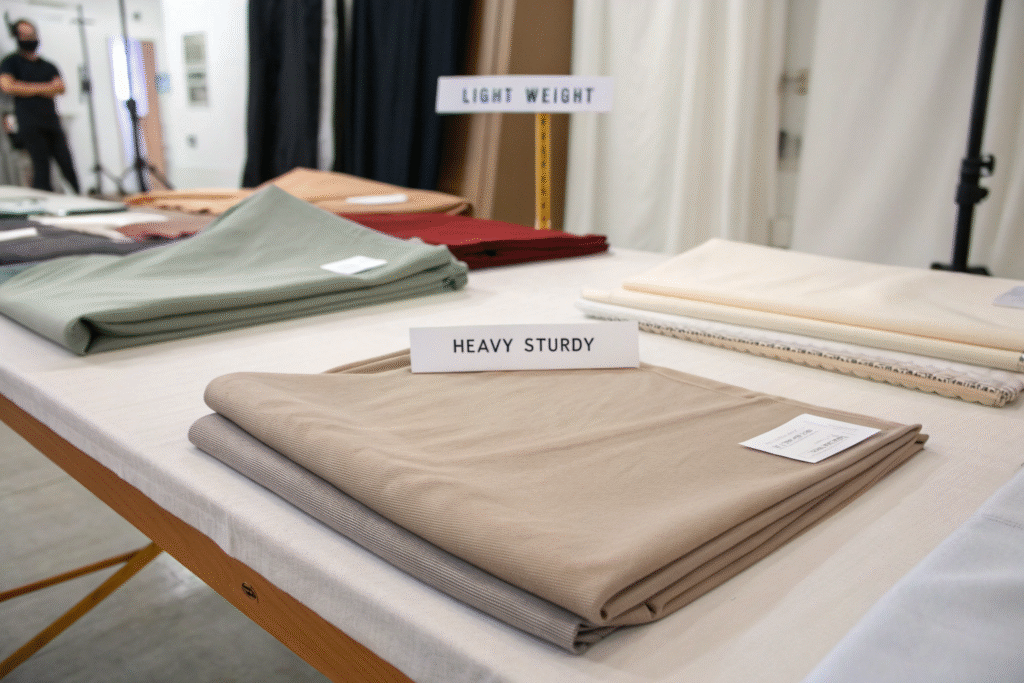
How Does Weight Influence Cost and Sourcing?
Fabric weight has a direct linear relationship with cost. Heavier fabric uses more yarn, which increases the cost of raw materials. A 14 oz denim will inherently be more expensive per meter than a 10 oz denim from the same mill. This affects your sourcing budget and final garment cost. Furthermore, heavier fabrics can impact logistics costs due to increased weight for shipping. Understanding this helps you make smarter sourcing decisions that balance quality and profitability.
What is the Best Denim Weight for My Product?
The "best" weight depends entirely on your end product and target customer. Here is a quick guide:
- For Shirts & Summer Apparel: Choose lightweight denim, 7-9 oz (235-305 GSM). It's soft and breathable.
- For Everyday Jeans & Jackets: Choose mid-weight denim, 10-14 oz (340-475 GSM). It offers the best balance of durability and comfort.
- For Premium Selvedge & Workwear: Choose heavyweight denim, 15+ oz (510+ GSM). It is ultra-durable and develops distinct fades.
At Fumao, we help you navigate these choices. We provide physical fabric swatches so you can feel the difference before you commit to a bulk order.
Conclusion
Understanding the difference between denim weight in ounces and GSM is more than a technicality—it's a fundamental skill for successful fashion sourcing. Ounces connect you to denim's heritage, while GSM offers global clarity. By knowing how to interpret and convert between them, you gain precise control over your material selection, ensuring your designs have the right look, feel, and performance. This knowledge empowers you to communicate effectively with global suppliers and avoid costly specification errors.
Ready to source the perfect denim for your next collection? Let's put this knowledge into practice. Partner with us to access a wide range of denim weights, from lightweight to heavyweight, all with transparent pricing and rigorous quality control. Contact our Business Director, Elaine, today at elaine@fumaoclothing.com to discuss your specific needs and request complimentary fabric swatches. Weave your vision with Fumao.

